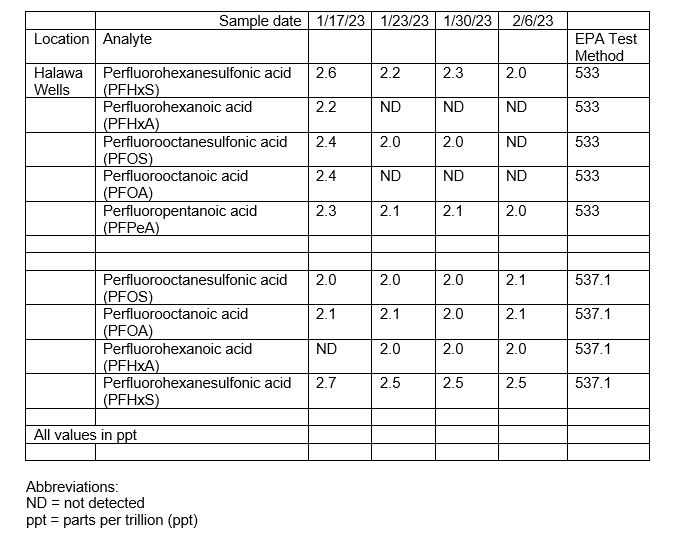Elevated PFAS Levels Found In Blue Mountains Water Supply

Table of Contents
Sources of PFAS Contamination in the Blue Mountains Water Supply
The presence of PFAS in the Blue Mountains water supply points to several potential sources of contamination. These persistent, man-made chemicals are incredibly stable and don't break down easily in the environment, leading to widespread contamination issues. Pinpointing the exact source(s) requires further investigation, but several possibilities exist:
- Nearby industrial sites: Past and present industrial activities, particularly those involving the manufacturing or use of PFAS-containing products, could be responsible for leaching these chemicals into the water system. Specific investigations are needed to identify any such sites in the vicinity of the water sources.
- Firefighting training areas: A common source of PFAS contamination is aqueous film-forming foam (AFFF) used in firefighting training exercises. These foams often contain high concentrations of PFAS, which can contaminate soil and groundwater over time. The presence of any such areas near the Blue Mountains water supply warrants immediate scrutiny.
- Landfills: Landfills can leach PFAS into the surrounding environment, particularly if they contain waste materials with PFAS content. Proper landfill management and lining are crucial in preventing such contamination.
- Runoff from agricultural areas: While less likely a primary source, agricultural runoff could contribute to PFAS contamination if PFAS-containing products were used in the area.
Identifying the specific sources of PFAS contamination in the Blue Mountains is crucial for implementing effective remediation strategies and preventing future contamination. Further investigation by the relevant authorities is paramount. This includes detailed analysis of soil and water samples, coupled with a comprehensive assessment of potential industrial and other sources in the region.
Health Risks Associated with Elevated PFAS Levels
PFAS exposure is linked to a range of adverse health effects. The long-term consequences of even low-level exposure remain a subject of ongoing research, but the potential risks are serious and warrant immediate attention for Blue Mountains residents. The EPA and WHO have identified several significant health concerns:
- Immune system dysfunction: Studies show a correlation between PFAS exposure and a weakened immune response, making individuals more susceptible to infections.
- Liver cancer: Exposure to high levels of PFAS has been associated with an increased risk of liver cancer.
- Thyroid disorders: PFAS has been linked to disruptions in thyroid hormone function, potentially leading to various thyroid disorders.
- Developmental delays in children: Exposure during pregnancy or early childhood can lead to developmental delays and other adverse health outcomes in children.
The potential impact on the health of Blue Mountains residents necessitates immediate action to mitigate exposure to these harmful chemicals. Regular monitoring of PFAS levels in the water supply and transparent communication with the community are vital steps in addressing this public health concern.
Government Response and Water Treatment Solutions
Following the detection of elevated PFAS levels, the local and state governments have initiated a multi-pronged approach to address the issue. This includes:
- Investigation into contamination sources: Authorities are actively investigating the origin of the PFAS contamination to identify and remediate the source(s).
- Water treatment solutions: The implementation of advanced water treatment methods is underway. This likely includes granular activated carbon (GAC) filtration, a proven technology for removing PFAS from water. Further investigation into the most effective and cost-efficient long-term solution is ongoing.
- Regulatory action: Regulations regarding PFAS in drinking water are being reviewed and may be strengthened to prevent future contamination incidents. This might involve stricter guidelines for industrial discharges and landfill management.
Regular updates to the public are critical, ensuring transparency and allowing residents to make informed decisions about their water consumption. Active community engagement in these processes is essential for building trust and achieving effective solutions.
Impact on the Blue Mountains Community and the Economy
The PFAS contamination has far-reaching implications for the Blue Mountains community and its economy. The uncertainty surrounding long-term health effects is causing anxiety among residents. Furthermore, the issue poses potential risks to:
- Tourism: The reputation of the Blue Mountains as a desirable tourist destination could suffer if concerns about water quality persist.
- Property values: Elevated PFAS levels could negatively impact property values in affected areas.
"The uncertainty is incredibly stressful," says local resident Sarah Miller. "We rely on the pristine environment of the Blue Mountains, and this contamination threatens everything we value."
Addressing the PFAS contamination is not just an environmental issue; it's crucial for protecting the well-being of the community and supporting the local economy. Long-term planning and investment are required to ensure a sustainable and healthy future for the Blue Mountains.
Protecting the Blue Mountains Water Supply: A Call to Action
The discovery of elevated PFAS levels in the Blue Mountains water supply highlights the urgent need for comprehensive action. The potential health risks associated with PFAS exposure are significant, and the impact on the community and economy cannot be ignored. We must demand swift and effective responses from our government and support initiatives that prioritize clean water for all.
Learn more about PFAS contamination in the Blue Mountains by contacting your local representatives and staying informed about government actions. Demand action to improve the water supply and protect your family from PFAS exposure. Support community initiatives aimed at improving water quality and holding polluters accountable.
Protecting our water sources is paramount. Ongoing monitoring and proactive remediation efforts are crucial to ensure the long-term health and prosperity of the Blue Mountains community and the preservation of its precious natural resources. Let's work together to safeguard our water supply and build a healthier future for generations to come.

Featured Posts
-
 Dpr Mendukung Presiden Prabowo Proyek Giant Sea Wall Menuju Realisasi
May 15, 2025
Dpr Mendukung Presiden Prabowo Proyek Giant Sea Wall Menuju Realisasi
May 15, 2025 -
 Indias Farm Sector To Benefit From Favorable Monsoon Predictions Ind Ra Report
May 15, 2025
Indias Farm Sector To Benefit From Favorable Monsoon Predictions Ind Ra Report
May 15, 2025 -
 Fanatics Your One Stop Shop For Boston Celtics Gear During Their Finals Run
May 15, 2025
Fanatics Your One Stop Shop For Boston Celtics Gear During Their Finals Run
May 15, 2025 -
 High Bacteria Levels In Rock Creek Rfk Jr Shares Photos Of Family Swim
May 15, 2025
High Bacteria Levels In Rock Creek Rfk Jr Shares Photos Of Family Swim
May 15, 2025 -
 Almeria Eldense Sigue El Partido En Directo Por La Liga Hyper Motion
May 15, 2025
Almeria Eldense Sigue El Partido En Directo Por La Liga Hyper Motion
May 15, 2025
Latest Posts
-
 Reviewing The Los Angeles Dodgers Offseason Activity
May 16, 2025
Reviewing The Los Angeles Dodgers Offseason Activity
May 16, 2025 -
 Top Dodgers Minor League Players To Watch Kim Hope Phillips And Miller
May 16, 2025
Top Dodgers Minor League Players To Watch Kim Hope Phillips And Miller
May 16, 2025 -
 Los Angeles Dodgers Promote Hyeseong Kim Impact On The Roster
May 16, 2025
Los Angeles Dodgers Promote Hyeseong Kim Impact On The Roster
May 16, 2025 -
 The Los Angeles Dodgers Offseason Strengths Weaknesses And Future Predictions
May 16, 2025
The Los Angeles Dodgers Offseason Strengths Weaknesses And Future Predictions
May 16, 2025 -
 Tracking The Progress Of Dodgers Prospects Kim Hope Phillips And Miller
May 16, 2025
Tracking The Progress Of Dodgers Prospects Kim Hope Phillips And Miller
May 16, 2025
